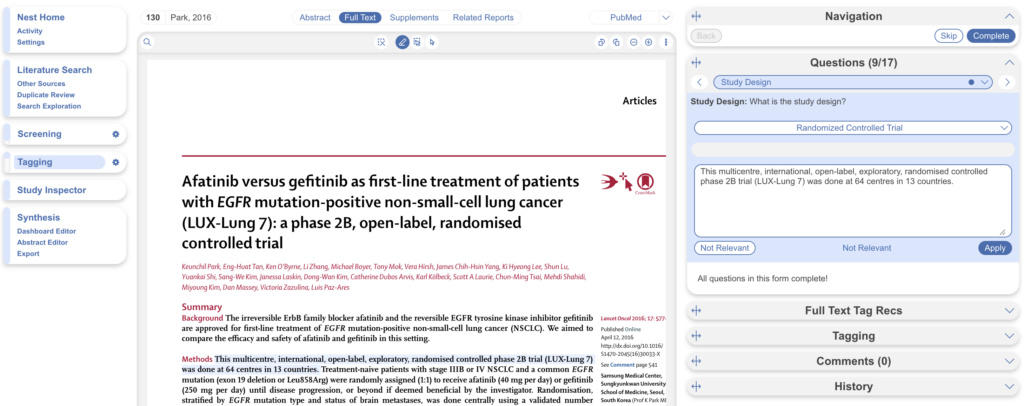Tagging is a process of applying a set of labels to the included studies in a review. AutoLit offers a built-in hierarchical tagging system connected to the data element set up for extraction. Hierarchical or non-hierarchical tagging systems can be implemented in other systematic review setups.
Why we tag #
Tagging is a form of data gathering and study organization. Even in quantitative meta-analyses, there are often qualitative properties that are useful to include in the study report, such as study type (ex. RCT vs. cohort vs. case series or prospective vs. retrospective) or differences in reported population (ex. adults vs. pediatric patients).
Tagging also assists in tracking how many studies in a review report each data element or include each intervention, which can be helpful context for the statistical analysis. Different forms of review may use tagging as the main form of data extraction. For example, in a common data elements review, which assesses what data elements are reported in a given field and how consistently they are reported, studies can be tagged with each data element reported, allowing the information to be synthesized.
Building Tagging Systems #
To start building a tagging system, lay out tags related to your study’s PICO elements. In order for the tags to be useful, tagging hierarchies need to be kept simple. If every study has a completely unique tag, then using the organization systems and drawing a synthesis from the tagging becomes more difficult. This issue can often be solved by removing the lowest conceptual level of tags. For example, in the tagging hierarchy below, if only a few studies report each individual drug, tagging with the drug class (outlined in red) may be more useful, and the individual drug tags (outlined in blue) can be deleted.

Tagging Hierarchies #
In hierarchical tagging systems, tags can be nested under broader umbrella tags. For example, tags for interventions of interest can be grouped together under an “Interventions” tag (highlighted purple in the hierarchy below). This structure makes organization more intuitive and allows for easy sorting and synthesis of information from study tags.
When applying tags from a hierarchical tagging structure, it’s important to apply tags from the lowest level possible. For example, when using the hierarchy above, studies reporting patients treated with Carboplatin should be tagged with “Carboplatin”, not with “Platinum-based Chemotherapy”. They will automatically be sorted under “Platinum-based Chemotherapy” due to the defined tag structure.
Applying Tags #
When applying a tag, it’s useful to note the text, figure, or table in the study that supports the application of that tag. For example, the text supporting the tag “adult patients only” on a study might read “We excluded pediatric patients.” These sentences should be copied directly from the study text where possible to make it easy to search the study and find the context. Referencing a figure or table may be appropriate in some cases, especially for tagging outcomes. For example, if the number of patients that died during the study is given in Table 2, the text associated with the tag may simply read “Table 2”. Again, this allows team members to easily locate the information in the study.

Recommendation: The PICO Framework: #
When tagging and data gathering, the PICO framework (Patients/population, Interventions/Comparators, and Outcomes) often makes sense as an organizational framework for your hierarchy. You can make PICO “Root nodes” and then nest appropriate concepts underneath:
Patient Characteristics: #
Patient characteristics can make up of age, gender, comorbidities, medication use history, and other information. We suggest limiting characteristics to age and sex unless other data is critical.
- Age
- Sex
Interventions (Therapies/Treatments): #
- Treatment (e.g. Tocilizumab, Remdesivir)
- Control arms (e.g. Placebo or Standard of Care)
- Adjunctive/Comparator therapies (e.g. Aspirin, guide devices, etc).
- Dosages or other treatment details
Outcomes: #
- Efficacy Outcomes (e.g. Mortality, Length of Hospital Stay)
- Safety outcomes
- Complications/adverse events
Study Design Information #
- Study Type (randomized controlled trial, retrospective cohort, etc)
- Inclusion and exclusion criteria (*only if relevant)
Nested Knowledge automatically gathers study metadata, which is bibliographic information about the included studies. Do not worry about creating tags for any of the following information:
- Title
- Authors
- Date
- URL
- DOI
- PubMed ID
Where to find information in studies #
While tagging, where can you usually find the information within studies? See this figure to guide you!


